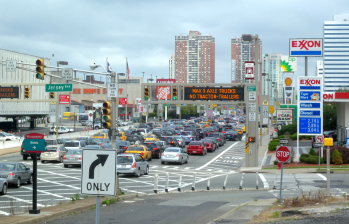NYC Health Department: Traffic Is Poisoning Our Air
 Estimated fine particle concentrations in winter 2008-2009
Estimated fine particle concentrations in winter 2008-2009In a first of its kind report for the city, the Department of Health has issued a wake-up call for New Yorkers of all stripes: Car and truck traffic is killing us, in more ways than one.
Collecting ground-level samples at 150 sites for a community air quality study conducted last winter [PDF], researchers measured for five pollutants emitted by vehicles and buildings. Among the findings: People in areas with higher traffic densities are subjected to higher levels of particulates (27 percent greater), elemental carbon (45 percent greater), and nitrogen dioxide (37 percent greater) than those in areas with less traffic. In addition to triggering allergies and other illnesses that lead to more hospitalizations and work absences, exposure to these toxins has been linked to heart diseases, lung diseases, and cancer.
While the effects on Midtown Manhattan and the Upper East Side make for compelling headlines, neighborhoods that get far less media play but are nonetheless saddled with crushing cut-through traffic, highway traffic and truck traffic, like Washington Heights and Hunts Point, are also hit hard.
"It confirms what we’ve known anecdotally," says Miquela Craytor of Sustainable South Bronx. In addition to regional traffic on the Bruckner Expressway, tens of thousands of trucks travel to and from Hunts Point weekly. Local residents, for the most part, are collateral damage. "The majority of folks in the Bronx aren’t driving to go to work in Manhattan."
Sustainable South Bronx is a member of the COMMUTE coalition, steadfast advocates for congestion pricing and BRT. "Things such as congestion pricing are a great tool that can lead to some behavioral changes that are necessary," Craytor says. "The other thing that certainly needs to happen is that we invest in our transit system. The Bronx still is underserved in many areas."
Yet local and state officials have left the MTA to wither, with the worst possibly to come. Despite the costs imposed by automobile use on the city’s economic and physical health, measures like pricing and bridge tolls, which would raise money for public transportation while reducing private vehicle traffic and its attendant pollution, are considered political non-starters. At least for now.


